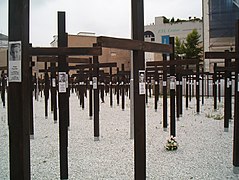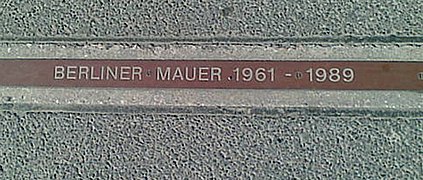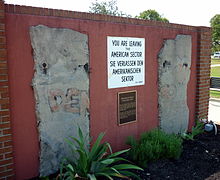
Berlin Wall
The Berlin Wall (German: Berliner Mauer, pronounced [bɛʁˌliːnɐ ˈmaʊɐ] ⓘ) was a guarded concrete barrier that encircled West Berlin of the Federal Republic of Germany (FRG; West Germany) from 1961 to 1989, separating it from East Berlin and the German Democratic Republic (GDR; East Germany).[a][1][3] Construction of the Berlin Wall was commenced by the government of the GDR on 13 August 1961. It included guard towers placed along large concrete walls,[4] accompanied by a wide area (later known as the "death strip") that contained anti-vehicle trenches, beds of nails and other defenses. The primary intention for the Wall's construction was to prevent East German citizens from fleeing to the West.[5]
This article is about the wall that surrounded West Berlin during the Cold War. For the border that divided most of East and West Germany, see German wall. For the video game, see The Berlin Wall (video game). For the ring wall around the historic city of Berlin, see Berlin Customs Wall.The Berlin Wall
Wall
 East Germany
East Germany East Berlin; see History of Berlin for further info
East Berlin; see History of Berlin for further info
13 August 1961
9 November 1989 – 1994[1]
- Border length around West Berlin: 155 km (96 mi)
- Border length between West Berlin and East Germany: 111.9 km (69.5 mi)
- Border length between West and East Berlin: 43.1 km (26.8 mi)
- Border length through residential areas in East Berlin: 37 km (23 mi)
- Concrete segment of wall height: 3.6 m (11.8 ft)
- Concrete segment of wall length: 106 km (66 mi)
- Wire mesh fencing: 66.5 km (41.3 mi)
- Anti-vehicle trenches length: 105.5 km (65.6 mi)
- Contact/signal fence length: 127.5 km (79.2 mi)
- Column track width: 7 m (7.7 yd)
- Column track length: 124.3 km (77.2 mi)
- Number of watch towers: 302
- Number of bunkers: 20
155 km (96.3 mi)
The Soviet Bloc propaganda portrayed the Wall as protecting its population from "fascist elements conspiring to prevent the will of the people" from building a communist state in the GDR. The authorities officially referred to the Berlin Wall as the Anti-Fascist Protection Rampart (German: Antifaschistischer Schutzwall, pronounced [antifaˌʃɪstɪʃɐ ˈʃʊtsval] ⓘ). The West Berlin city government sometimes referred to it as the "Wall of Shame", a term coined by mayor Willy Brandt in reference to the Wall's restriction on freedom of movement.[6] Along with the separate and much longer inner German border, which demarcated the border between East and West Germany, it came to symbolize physically the Iron Curtain that separated the Western Bloc and Soviet satellite states of the Eastern Bloc during the Cold War.[7]
Before the Wall's erection, 3.5 million East Germans circumvented Eastern Bloc emigration restrictions and defected from the GDR, many by crossing over the border from East Berlin into West Berlin; from there they could then travel to West Germany and to other Western European countries. Between 1961 and 1989, the Wall prevented almost all such emigration.[8] During this period, over 100,000[9] people attempted to escape, and over 5,000 people succeeded in escaping over the Wall, with an estimated death toll of those murdered by East German authorities ranging from 136[10] to more than 200[7][11] in and around Berlin.
In 1989, a series of revolutions in nearby Eastern Bloc countries—in Poland and Hungary in particular—caused a chain reaction in East Germany.[12] In particular, the Pan-European Picnic in August 1989 set in motion a peaceful development during which the Iron Curtain largely broke, the rulers in the East came under pressure to cease their repressive policies, the Berlin Wall fell and finally the Eastern Bloc collapsed.[13][14][15] After several weeks of civil unrest, the East German government announced on 9 November 1989 that all GDR citizens could visit the FRG and West Berlin. Crowds of East Germans crossed and climbed onto the Wall, joined by West Germans on the other side in a celebratory atmosphere. Over the next few weeks, souvenir hunters chipped away parts of the Wall.[7] The Brandenburg Gate, a few meters from the Berlin Wall, was opened on 22 December 1989. The demolition of the Wall officially began on 13 June 1990 and was completed in 1994.[1] The fall of the Berlin Wall paved the way for German reunification, which formally took place on 3 October 1990.[7]
Background
Post-war Germany
After the end of World War II in Europe, what remained of pre-war Germany west of the Oder-Neisse line was divided into four occupation zones (as per the Potsdam Agreement), each one controlled by one of the four occupying Allied powers: the United States, the United Kingdom, France and the Soviet Union. The capital of Berlin, as the seat of the Allied Control Council, was similarly subdivided into four sectors despite the city's location, which was fully within the Soviet zone.[16]
Within two years, political divisions increased between the Soviets and the other occupying powers. These included the Soviets' refusal to agree to reconstruction plans making post-war Germany self-sufficient, and to a detailed accounting of industrial plants, goods and infrastructure—some of which had already been removed by the Soviets.[17] France, the United Kingdom, the United States, and the Benelux countries later met to combine the non-Soviet zones of Germany into one zone for reconstruction, and to approve the extension of the Marshall Plan.[7]
Concerts by Western artists and growing anti-Wall sentiment
David Bowie, 1987
On 6 June 1987, David Bowie, who earlier for several years lived and recorded in West Berlin, played a concert close to the Wall. This was attended by thousands of Eastern concertgoers across the Wall,[111] followed by violent rioting in East Berlin. According to Tobias Ruther, these protests in East Berlin were the first in the sequence of riots that led to those of November 1989.[112][113] Although other factors were probably more influential in the fall of the Wall,[111] upon his death in 2016, the German Foreign Office tweeted "Good-bye, David Bowie. You are now among #Heroes. Thank you for helping to bring down the #wall."[114]
Bruce Springsteen, 1988
On 19 July 1988, 16 months before the Wall came down, Bruce Springsteen and the E Street Band, played Rocking the Wall, a live concert in East Berlin, which was attended by 300,000 in person and broadcast on television. Springsteen spoke to the crowd in German, saying: "I'm not here for or against any government. I've come to play rock 'n' roll for you in the hope that one day all the barriers will be torn down".[115] East Germany and its FDJ youth organization were worried they were losing an entire generation. They hoped that by letting Springsteen in, they could improve their sentiment among East Germans. However, this strategy of "one step backwards, two steps forwards" backfired, and the concert only made East Germans hungrier for more of the freedoms that Springsteen epitomized. While John F. Kennedy and Ronald Reagan delivered their famous speeches from the safety of West Berlin, Springsteen's speaking out against the Wall in the middle of East Berlin added to the euphoria.[115]
David Hasselhoff, 1989
On 31 December 1989, American TV actor and pop music singer David Hasselhoff was the headlining performer for the Freedom Tour Live concert, which was attended by over 500,000 people on both sides of the Wall. The live concert footage was directed by music video director Thomas Mignone and aired on broadcast television station Zweites Deutsches Fernsehen ZDF throughout Europe. During shooting, film crew personnel pulled people up from both sides to stand and celebrate on top of the wall. Hasselhoff sang his number one hit song "Looking for Freedom" on a platform at the end of a twenty-meter steel crane that swung above and over the Wall adjacent to the Brandenburg Gate.[116] A small museum was created in 2008 to celebrate Hasselhoff in the basement of the Circus Hostel.[117]








